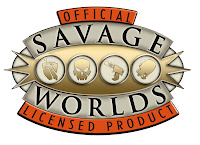Genesys
The wonderful narrative dice mechanics that power the Star Wars roleplaying game by Fantasy Flight Games is going to be published as a generic game system this fall. FFG announced on Tuesday that the core rulebook will be available.
The game will be built on the very same rules that was introduced in Edge of the Empire and is in Age of Rebellion and Force and Destiny. It looks like there is a slight change in the symbols on the dice, making it slightly less Star Wars, but it appears the dice will be interchangeable.
The announcement also mentions a few different genres that will be represented.
See the announcement here and quoted below...
The game will be built on the very same rules that was introduced in Edge of the Empire and is in Age of Rebellion and Force and Destiny. It looks like there is a slight change in the symbols on the dice, making it slightly less Star Wars, but it appears the dice will be interchangeable.
The announcement also mentions a few different genres that will be represented.
See the announcement here and quoted below...
Blast hordes of reanimated skeletons with holy fire, explore new worlds in a steam-powered zeppelin, match wits with alien warlords, or invent your own entirely unique world. Unlimited adventure awaits you in a new roleplaying system limited only by your imagination!
Fantasy Flight Games is proud to announce Genesys, a new roleplaying game system compatible with any setting, and featuring the critically acclaimed Narrative Dice System.
The Genesys experience begins with the Genesys Core Rulebook, which features an explanation of the narrative dice system and core mechanics of the game, an overview of five different settings in which to place campaigns, and advice for Game Masters to craft a myriad of adventures with unparalleled freedom.
A Dynamic Dice System
Genesys utilizes the Narrative Dice System which allows for creative storytelling that goes beyond success and failure, and allows every dice roll to impact the story in dramatic ways.
Every challenge your character faces will have them rolling some combination of Ability and Difficulty dice, known as a dice pool, to determine the results. Ability dice come from your character’s unique skills and characteristics, and provide Success and Advantage symbols. Difficulty dice come from the difficulty of the task your character is trying to achieve, and provide Failure and Threat symbols. Lockpicking an old, rusty door may only provide one Difficulty die, while hacking through a hi-tech firewall designed by a master codesmith may provide many more Difficulty dice. To succeed in whatever task your character is trying to accomplish, a player simply must roll more Success symbols than Failure symbols.
While this may seem simple, the addition of the Advantage and Threat symbols make the results far from binary. Rolling more Advantage symbols yields some positive side effect, regardless of success or failure of the task. This can include things like finding unexpected cover in a firefight or remaining unnoticed while hacking a computer. Meanwhile, rolling Threat means some negative side effect has occurred. Maybe your character drops their weapon after a successful attack or takes longer than expected to track their quarry through the wilderness.
When your character is an expert in the field, or when a task is truly difficult, Ability dice and Difficulty dice can be upgraded to Proficiency and Challenge dice, respectively. Proficiency dice, like Ability dice, feature Success and Advantage symbols, but also include the Triumph symbol. The Triumph symbol not only represents a Success, but also provides a massive side benefit to your action. This might be inflicting a critical injury on a foe or triggering a powerful ability on a weapon. Inversely, the Challenge die features Failure and Threat symbols, but also includes the powerful Despair symbol. Rolling this icon not only counts as a Failure, but indicates a significant bane or side effect to your action. Your character may fall off the rope they are trying to climb, or run out of ammo in the middle of a gunfight. These effects can drastically impact the course of your game, and make every dice roll an exciting event.
Your dice pool can further be modified by Boost and Setback dice. Boost dice feature Success and Advantage symbols, and are added to your roll when the circumstances around the task you are trying to achieve are beneficial. Maybe your character has hacked a computer like this before, or they have ample time to complete the task; your GM will likely add Boost dice to your pool. Setback dice, on the other hand, feature Failure and Threat symbols, and represent complications to the task at hand. Maybe your character is trying to act in the dark, or they don’t have the resources they need.
With the variance provided by these clever Advantage and Threat icons, the possibilities of results are limited only by you and your GM’s creativity.
Unlimited Adventure
From science fiction to fantasy to steampunk, the Genesys Core Rulebook features everything you need to both craft and partake in adventures of all kinds. Providing character templates, equipment, and foes for five wildly different settings, the Genesys Core Rulebook is a pathway to any roleplaying adventure you can imagine. The settings detailed in the book are as follows:
Fantasy
Magic, monsters, heroic warriors, and evil overlords—fantasy has all the makings of a good adventure. There’s a reason it’s the basis for so many games and central to the roots of roleplaying.
Despite being instantly recognizable and familiar, fantasy is an incredibly varied genre, with numerous subdivisions. However you decide to style your fantasy game, Genesys’ customizability makes it perfect for tailoring to the game you want.
Steampunk
Although the term "steampunk" originated in the 1980s, the foundations of the genre go back much further. As is often the case when it comes to defining and categorizing fiction and its genres, opinions differ. But a strong argument can be made that the origins of steampunk lie in what are more commonly considered the earliest science fiction stories. The fantastic science and contraptions shown in the works of Jules Verne, H. G. Wells, and Mary Shelley are based in the technology of the 1800s, but go far beyond what was possible at the time. This advance beyond this historical realism is the core of steampunk.
Weird War
Weird war settings are alternate-universe historical settings where one or another of humanity’s global wars spun out of control and changed history as we know it. Rooted in historical fiction and war stories, weird war settings combine real-world history and alternate history, liberally sprinkling them with horror and sci-fi elements to create unique and exciting stories.
Weird war settings can take place in any historical era. You can fight werewolves with the Roman legions, chase ghost ships during the Napoleonic Wars, or protect villagers from packs of ghouls in the mountains of Afghanistan.
Modern Day
Modern day settings are a catch-all that encompass several sub settings including, but not limited to, modern horror, spy thrillers, detective stories, and military adventures. These settings are home to countless action movies, video games, spy novels, and a host of police procedurals and hard-boiled detective stories. In modern settings, hard men and women battle against crooked bureaucrats, vicious killers, terror cells, and the mob as a departure from elves, zombies, and aliens.
Science Fiction
Science fiction is, as the name implies, a genre that merges scientific theory and accuracy with fictional stories. People often use the term to describe so-called “hard sci-fi” and “soft sci-fi” interchangeably. Hard sci-fi focuses more on grounding the story with scientific realism, while soft sci-fi worries less about scientific accuracy and generally has many more fantastical elements.
One thing you should keep in mind about hard and soft science fiction is that these aren’t rigorous denotations. Each is one end of a broad spectrum, with most works of science fiction falling somewhere in between. Most of the science fiction you read or watch will have elements of realism alongside fantastical inventions, but will probably trend toward one end of the spectrum or the other. Fantasy Flight Games' own Android setting is the perfect example of grounded sci-fi. If you choose to explore the Android Universe in Genesys, you'll enter a not-so-distant future where mega-corporations run sprawling cities, and runners explore the digital frontier of a network linking every electronic device on the earth.
The science fiction setting found in the Genesys Core Rulebook is further broken down into more grounded science fiction and space operas, offering a wide swathe of tropes, equipment, and adversaries.
The Genesys system isn't limited to the settings found in the core rulebook, either. Keep your eyes out for future supplemental material that will provide in-depth guides to additional settings!
Choose Your Path
Race into a blazing inferno as a firefighter, fight demons on a space station, or stop a mystical ritual—with Genesys, any story can be told. One book, unlimited adventures.
Tell your own stories and pick up the Genesys Core Rulebook (GNS01) when it releases in the fourth quarter of 2017
I'm thrilled by this news. I've been following many of the hack projects that were taking these rules to different campaign settings and genres. There have been several outstanding home made efforts already. But with this book, everything is changed!
I can't wait!










Comments
Post a Comment